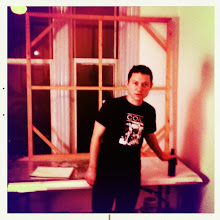-All too often, we make art in the same zombie-like slumber in which we go to our day jobs--joylessly, dutifully and unquestioningly. We should instead be sorcerers or witches when we make art. Not insatiable and unthinking, but willful, self-reflective, and focused on the changes we want to see occur in ourselves and our circumstances. We should conceive of art much as Aleister Crowley defined magick: "the Science and Art of causing Change to occur in conformity with Will."
-Whenever we create an artwork, we should have precise ends in mind, whether the desired result is inciting passion, changing minds, or simply paying the rent. The part that counts as magick is not only the alteration of reality, but also the precise determination of one's intentions. Occult literature is full of cautionary tales of muddy intentions and tragically backfired spells.
-Even if we doubt the efficacy of magick, suspending one's disbelief and conceiving of art as having magickal effects induces a heightened sense of responsibility. Your audience may not see the corners that have been cut, but the gods most certainly will. An artwork, after all, is the sum total of a series of decisions an artist has made. Magick asks that each decision count.
-It is a common complaint that art is overly commercialized, professionalized, or otherwise embedded in systems anathema to our most cherished notions of what art is or should be. William S. Burroughs reminds us of art's provenance in magic and ritual--cult as opposed to culture: "all art is originally magical in origin...and by magical I mean intended to produce very definite results." Asking what spell an artwork is casting dispels much of the monetary and media glare that obscures the meaning of so much art nowadays.
-Nearly all magickal undertakings begin with a banishing, which prepares a ritual space for magickal work by casting out unwanted influences. While certainly indispensible when setting up a studio, it might also be helpful to inundate your local arts district with bonfires of sage before any substantial work is begun at large. In fact something more extreme may be in order. While preparing a ritual space, the four cardinal points are sometimes invoked by imagining angels or other higher beings protecting the space of the ritual. Imagine, perhaps, four figures of rage and exorcism: David Wojnarowicz to the North, Valerie Solanas to the South, Diamanda Galas to the East, and Pier Paolo Pasolini to the West, spitting face-melting wrath, icy attitude, rotten blood and bad breath to fend off the demonic agents of apathy, disinformation, and bigotry lurking in the corners.
-The century-long experiment of modernism, with its on-going collective process of reduction and purification, could be thought of as an elaborate banishing from art of traditional formal constructs and the cultural values they express. Think, for instance, of Alexander Rodchenko's monochromes, and their declared intent of concluding the historical narrative of painting so that artists' energies might be redirected from the easel to the construction of a new society. Likewise, Ad Reinhardt's "Art as Art" manifesto consists in a litany of negations, banishing received notions about art from his practice and, symbolically, from the future of art.
-The preparation of ritual space has analogues in the creation of individual works of art and the organization of a studio. The four corners of a two-dimensional rectangular surface, for instance, can be thought of as requiring banishing or can be coordinated with the cardinal points. Likewise, temple furniture--altar, circle, dagger, wand, cup, robe, etc.--can provide metaphors for thinking about the tools required for the practice of different mediums.
-In Book Four, Crowley's major work on the theory and practice of magick, he outlines the various operations of sorcery as roughly consisting in evocation, consecration, divination, fascination, love and hate, destruction, creation, dissolution, and invocation. Any one or combination of these operations can be used by an artist to focus his/her process of creation and his/her intentions for a given artwork's effect on its viewers. The operation of divination, "in which a live spirit is made to control operations of the hand or brain of the Magician," can enhance methods for relinquishing egoistic control of results or utilizing chance in the studio. On the other hand, works of fascination, "such as operations of invisibility, and transformations of the apparent form of the person or thing concerned," relate to artworks that willfully distort or enhance viewers' perceptions. Additional occult processes and abilities should be amended to Crowley's list as possible aesthetic goals, such as clairvoyance or the traditional shamanic task of healing.
-Works of destruction in magick, otherwise known as "magickal attack," are frequently taboo for contemporary practitioners of the occult. Their analogues in art, however, are often valued positively: critique, political commitment, satire, irony, etc. Given the sheer scale and force of the opposition--the economic, social, political, and ecological quagmires transpiring globally--artists would do well to train themselves in some of the darker arts. And politically-minded occultists should look to visual artists for the candor and aggression with which they have confronted various figures of power and agents of control over the course of the last century.
-Magick and art compel or repel belief in equally forceful manners. You either "get it" or you don't. There's no arguing or convincing otherwise on either side. The rare change-of-mind has the force of a revelation or epiphany, and takes the form of a conversion.

No comments:
Post a Comment